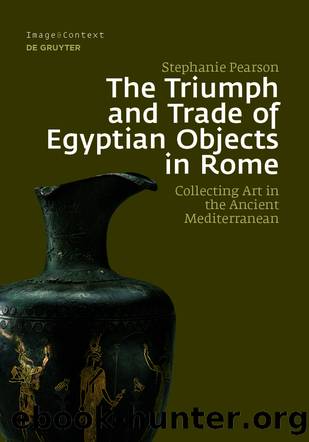The Triumph and Trade of Egyptian Objects in Rome by Stephanie Pearson

Author:Stephanie Pearson
Language: eng
Format: epub
Publisher: De Gruyter
Published: 2021-02-16T14:44:25.506000+00:00
Fig. 83: Frescoes depicting doors inlaid with tortoiseshell, framed by columns with Alexandrian capitals. Cubiculum M, Villa of P. Fannius Synistor, Boscoreale. 50-40 BC. New York, The Metropolitan Museum of Art.
Pearls are also noted among Cleopatraâs riches, and like tortoiseshell are a product of both the Red Sea and India. Mummy portraits from Egypt show such an abundance of pearl jewelry that it must have been readily available, at least to these relatively well-to-do individuals (Fig. 81). The import of pearls to Roman Italy is attested most spectacularly for Pompey. In his triumph over Mithridates, Armenia, Pompey processed a number of monuments made of pearls: thirty-three pearl crowns, a grotto made of pearls, and a pearl portrait of himself.25 This seems to contradict Fenestellaâs claim that Augustusâ conquest of Alexandria led to the importation of pearls to Rome, since Pompeyâs triumph took place in 61 BC.26 But Fenestellaâs statement should not be taken to mean that there had previously been no pearls whatsoever imported to Rome. Rather, it typifies the Roman view of Egypt as the home of luxury, and of the impact of Augustusâ conquest in the eyes of contemporary authors. It also suggests that the importation of pearls increased dramatically after the conquest. Certainly this is seen in the first century BC and AD in the fairly modest city of Pompeii, where forty-eight pairs of pearl earrings have been discovered. At the same period, eight different funerary inscriptions from Romeâs Via Sacra name individuals and families as margaritarii, pearl traders.27
Silk almost certainly came not from India but through it, from China. Before the imperial period, silk was produced on the island of Cos by Asia Minor; the fabric was apparently so well-known that Augustan poets refer to it by the name coae vestes. But China surpassed Cos as the primary producer during the imperial period. Chinese silks reached Rome through the Indian harbors named in the Periplus; perhaps India even made its own silk, but in any case seems to have been a minor player compared to China.28 Silk threads were used as the base for silver- and gold-wrapped threads that were then woven into spectacular textiles.29 For the games that Julius Caesar held in conjunction with his quadruple triumph, he apparently had awnings made out of silk.30
It is worth noting that the Romans in Italy eagerly acquired costly goods from India, but mostly do not seem to have sought out Indian art. The ivory furnishing just mentioned in the shape of an Indian goddess found in Pompeii is a great rarity as a piece of identifiably Indian art imported to Roman Italy.31 This is a stark contrast to the Roman acquisition of Egyptian art. Clearly the trade routes would have allowed the Romans to have acquired Indian goods beyond simply pepper and pearls, but there seems to have been little desire to. Roman authors may rail against the abundant import of Indian spices and pearls, but Indian cloth, art, and jewelry do not feature in Roman markets the way Egyptian ones do.
Download
This site does not store any files on its server. We only index and link to content provided by other sites. Please contact the content providers to delete copyright contents if any and email us, we'll remove relevant links or contents immediately.
| Africa | Americas |
| Arctic & Antarctica | Asia |
| Australia & Oceania | Europe |
| Middle East | Russia |
| United States | World |
| Ancient Civilizations | Military |
| Historical Study & Educational Resources |
The Daily Stoic by Holiday Ryan & Hanselman Stephen(2706)
The Fate of Rome: Climate, Disease, and the End of an Empire (The Princeton History of the Ancient World) by Kyle Harper(2434)
People of the Earth: An Introduction to World Prehistory by Dr. Brian Fagan & Nadia Durrani(2346)
Ancient Worlds by Michael Scott(2101)
Babylon's Ark by Lawrence Anthony(2068)
Foreign Devils on the Silk Road: The Search for the Lost Treasures of Central Asia by Peter Hopkirk(2054)
India's Ancient Past by R.S. Sharma(1984)
MOSES THE EGYPTIAN by Jan Assmann(1970)
The Complete Dead Sea Scrolls in English (7th Edition) (Penguin Classics) by Geza Vermes(1838)
Lost Technologies of Ancient Egypt by Christopher Dunn(1797)
The Daily Stoic by Ryan Holiday & Stephen Hanselman(1767)
The Earth Chronicles Handbook by Zecharia Sitchin(1743)
24 Hours in Ancient Rome by Philip Matyszak(1676)
Alexander the Great by Philip Freeman(1645)
Aztec by Gary Jennings(1543)
The Nine Waves of Creation by Carl Johan Calleman(1519)
Curse Tablets and Binding Spells from the Ancient World by Gager John G.;(1510)
Before Atlantis by Frank Joseph(1483)
Earthmare: The Lost Book of Wars by Cergat(1466)
